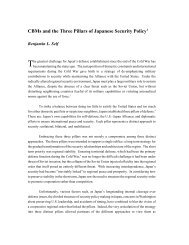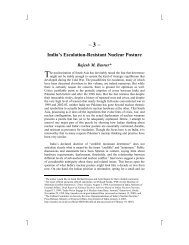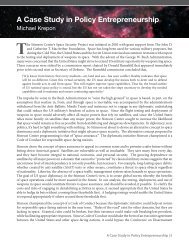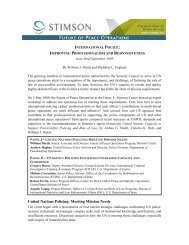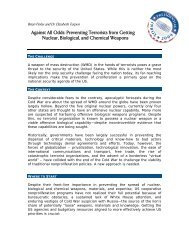Indian Climate Policy: Choices and Challenges - The Stimson Center
Indian Climate Policy: Choices and Challenges - The Stimson Center
Indian Climate Policy: Choices and Challenges - The Stimson Center
You also want an ePaper? Increase the reach of your titles
YUMPU automatically turns print PDFs into web optimized ePapers that Google loves.
22 | MAHANTA<br />
FUTURE POLICY IMPLICATIONS<br />
<strong>The</strong> successful implementation of a national water policy responsive to the<br />
climate challenge will require both a dependable knowledge base <strong>and</strong> appropriate<br />
institutional support at the national, regional, <strong>and</strong> local levels. On the<br />
informational front, there is need to build up a reliable time-series database with<br />
trends for relevant hydrological variables. <strong>The</strong> application of predictive models<br />
can then help formulate estimates of the potential impacts of future changes in<br />
hydrological systems. Continuous monitoring of water variability in response to<br />
changing climatic conditions will also be necessary. Comprehensive, credible<br />
assessments of basin-scale potentials for climate change resilience of water<br />
resources through watershed development, groundwater recharge, water saving<br />
technologies, <strong>and</strong> high output/low input-based practices can be carried out.<br />
Simultaneously, relative water footprints, food footprints, <strong>and</strong> ecological<br />
footprints of different water options should also be integrated in water resource<br />
planning.<br />
On the institutional side, setting up legal <strong>and</strong> organizational structures to ensure<br />
integrated water management for climate change, regulatory mechanisms to<br />
monitor water use efficiency, <strong>and</strong> bottom-up water resource governance is an<br />
urgent need. Enacting credible, legally enforceable, community-led regulation<br />
can ensure the sustainable management of both surface water <strong>and</strong> groundwater<br />
supplies through the sustenance of existing replenishment systems. Local<br />
institutional support can also foster community resilience to water stresses by<br />
securing access to diverse sources – e.g., ensuring that households possess their<br />
own rainwater tanks – <strong>and</strong> protecting existing water sources by low-cost<br />
technologies that minimize over-extraction of groundwater or surface water<br />
(respecting environmental flow requirements where applicable.) <strong>The</strong> emphasis<br />
should be on targeting climate <strong>and</strong> water policy action at appropriate scales<br />
through innovation <strong>and</strong> diversity, flexibility <strong>and</strong> accountability. 7<br />
CONCLUSION<br />
<strong>The</strong> national water mission has to take off on a sound trajectory to ensure<br />
sustainable water security for all <strong>Indian</strong>s. This may require hard political<br />
initiatives to pass on more decentralized decision-making capacities to local<br />
governments (which are often lacking at present.) In turn, the strength of local<br />
institutions – particularly those which operate <strong>and</strong> maintain water infrastructures<br />
– has to be enhanced with adequate resources. It is a paradox that India<br />
possesses an apparently vigorous planning mechanism with sufficient investment<br />
7 Sovacool, B.K. <strong>and</strong> M.A. Brown. “Scaling the <strong>Policy</strong> Response to <strong>Climate</strong> Change,” <strong>Policy</strong> <strong>and</strong> Society, Vol.27,<br />
No.4 (2009).



